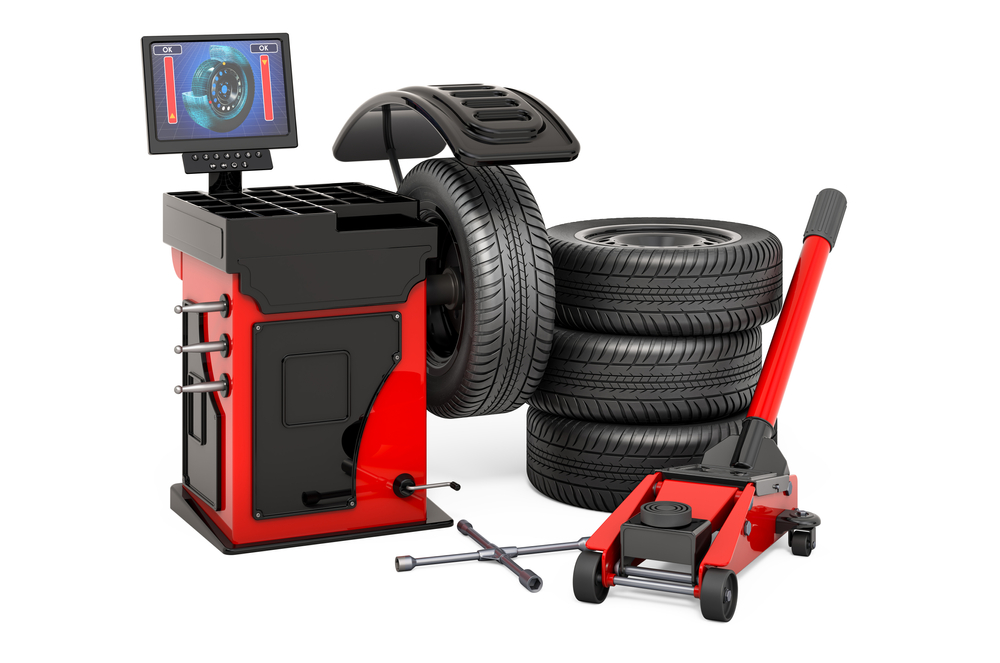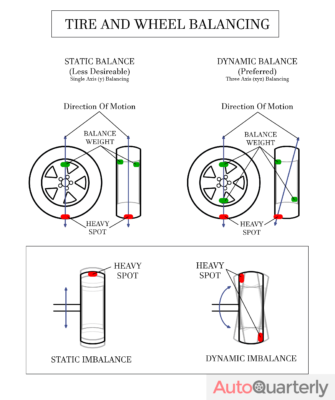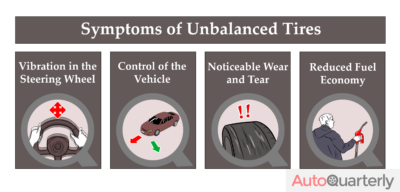When most people think about regular car maintenance, things like oil changes and adding washer fluid immediately come to mind. Getting your tires balanced, however, should also be at the top of your list. It is generally recommended that you have your tires balanced about every 10,000 miles.
Fortunately, tire balancing costs are quite modest on most vehicles. Here’s everything you need to know.
How Much Does Tire Balancing Cost?
If you pay a professional to balance your tires, you will typically pay somewhere between $10 to $40 per tire. In the vast majority of cases, you will want to balance all four of your tires at the same time in order to ensure your drive is as smooth as possible. This means you will usually pay anywhere from $40 to $160 to balance the tires of your entire vehicle.
The specific price will depend on many factors including which mechanic shop you go to, the size and brand of the tires you have, and the average cost of living in your area. With this in mind, it is always a good idea to call around to multiple different mechanics and tire shops in your area to find out which ones are the most affordable.
What Exactly Is Tire Balancing?
In order to get the best performance from your tires it is important that they are balanced properly. This means that the weight of the tire itself is evenly distributed. There are two main types of tire imbalances that need to be accounted for.
Static Imbalances
Static imbalances are when one area of the tire is either lighter or heavier than the rest in terms of how it travels around the wheel. If you put the tire on stand that allows it to spin freely, the heaviest point will always move to the bottom. Static imbalances will cause the tire to vibrate up and down while driving.
Dynamic Imbalances
Dynamic imbalances are when there is an imbalance on the width of the tire. For example, if your tire has worn out faster on the outer edge, the weight will be off balance. This problem is often easier to identify with just a visual inspection. Tires that have dynamic imbalances will vibrate side to side while driving.
Any Tire Can Be Out of Balance
Tires are manufactured using precise machinery to help ensure they are balanced when they come off the line. Even then, however, small imperfections can occur, which throws them slightly off balance. Therefore, tire shops routinely balance each tire before putting them on.
When driving your vehicle, the tires will wear unevenly, which will slowly throw them off balance. This is why it is highly recommended to have your tires balanced every 6,000 to 10,000 miles.
Symptoms of Unbalanced Tires
While it is recommended that you get your tires balanced at least every 10,000 miles, many people do not take this advice.
As there are several ways that a tire could become unbalanced (e.g. aggressive driving, direct tire damage etc.), it’s a good idea to learn how to tell if one or more of your tires is unbalanced. That way you can recognize (and fix) it, even if they’re not regularly checked.
The following are the three main symptoms to watch for.
Vibration in the Steering Wheel
The first thing you are likely to notice is that there is a vibration in your steering wheel. The vibration will get worse the further out of balance your tires become. If you are driving on a smooth road and notice a vibration or jerking feeling in your hands, it is definitely time to get your tires checked.
Control of the Vehicle
When tires become significantly unbalanced it can influence your ability to maintain control of your vehicle. When tires are not even, they will not maintain proper contact with the road, which will reduce your ability to quickly turn or stop.
Noticeable Wear and Tear
Unbalanced tires will not experience even wear like they are supposed to. If you notice that one area of your tire is becoming worn down more quickly than the rest, it is possible that they need to be balanced.
If uneven wear and tear becomes too significant, the tire will need to either be replaced or shaved down to even it out. This will be much more costly than simply balancing your tires, so make sure you take action as soon as you notice a problem.
Reduced Fuel Economy
When the tires on a vehicle are not balanced, they do not operate as efficiently. This will increase the amount of fuel your car needs to get from place to place. If you are the type of person who keeps a close eye on your fuel economy, you will want to have your tires balanced if you notice the efficiency is dipping down.
For more information on the symptoms of (and solutions for) unbalanced tires, check out our complete guide to unbalanced tires.
Where to Get Your Tires Balanced
If you want to get your tires balanced by a professional, you will have a few options in most areas. The option you choose can have a big impact on how much it costs and how long it takes.
Tire Shop
Going to a place that specializes in selling tires is the obvious choice, as well as the most popular. Whenever you buy new tires, they will be balanced prior to being installed, so you can be certain that a tire shop has the right equipment to do the job. In addition, the people at this shop likely do tire balancing many times per day, so you can be confident that they know what they are doing.
If you purchased your tires at a local tire shop, make sure you give them a call first. Some of these businesses will balance your tires for free, or for a discount, if they were originally purchased at that location. They may also offer free tire rotation services.
Auto Mechanic
The next option is to bring your vehicle to a mechanic and have them take care of it for you. This is something that any mechanic should be able to perform, though some smaller shops might not have the proper machines if this is not the type of work that they normally perform.
Warehouse Club Stores
If you have a membership at a warehouse store like Sam’s Club or Costco, you may want to check with them on their prices for tire balancing. These stores often provide this service at a discount to help make their membership more attractive. Since balancing tires is not an extremely complex process, there is no reason to look only at shops that specialize exclusively in auto services for this type of work.
How Tires Are Balanced
Whether being done on brand new tires, or rebalancing tires after use, the same process will be followed. If you happen to have access to a tire balancing machine and are doing this work yourself, make sure you take the necessary safety precautions. This machine will rapidly spin the tire, which can cause serious injuries if you come in contact with it, or if an article of clothing gets stuck on it.
1. Remove the Tire
The first thing that is done when balancing tires is removing the tires from the vehicle. Most mechanics and tire shops will have a car lift so they can remove all four tires at the same time. If one is not available, it is fine to just do one at a time. Since the tires are coming off anyway, however, this is a great opportunity to rotate the tires to help promote even wear.
2. Mount on Balancing Machine
Once a tire is off the vehicle, it needs to be mounted onto the balancing machine. There are a variety of different machines, but the process is typically going to be similar to mounting it on a vehicle. If the tire already has wheel weights or center caps in place, make sure they are removed prior to mounting to ensure an accurate test.

3. Enter Tire Information
Most tire balancing machines will require that you enter in information about the tire including its measurements. Some machines will also ask you to enter information about the vehicle that the tire will be used on so it can incorporate that information into the tests. It may also require that you enter the tire pressure.
4. Perform Test
Once done entering information, the machine will begin the test. This involves the machine applying pressure on the tire to simulate driving and turning it rapidly while taking the relevant measurements. In most cases, this will only take a few moments.
5. Add Tire Weights as Instructed
Once the test has completed, the machine will indicate where tire weights are needed, and how much weight is required. You simply add the number of weights that the machine says are required onto the position of the tire where they are needed. These weights will normally be added to the rim of the wheel close to where the tire itself meets the rim.
6. Retest the Tire
Once the weights are secured in place, run the test again to make sure everything is properly balanced. You may need to add weight and retest multiple times to get it perfect.
7. Place Tires Back on Vehicle
Now that the tire is properly balanced, it can be dismounted from the machine and mounted back onto your vehicle. Repeat this process for each of the tires.
Can You Balance Tires Yourself?
If you are looking to save on tire balancing costs, you may wonder if this is something you can do on your own. Balancing tires is a precision task that is best done using a specially designed machine that can accurately measure the tires.
This is not a machine most people will have in their home garage, which makes it very difficult to do properly. With this in mind, most people cannot balance their own tires successfully.
Enjoy Extended Tire Life and Improved Performance
While nobody wants to have to spend money on their vehicle, proper maintenance is a necessity. The tire balancing costs should always be factored in when estimating the total cost of ownership for any vehicle. Investing a little bit of money into getting your tires balanced a couple of times per year will help you to get the most life out of your tires, and allow you to enjoy a smooth, safe, and comfortable ride every time you hop in the car.




